SpatImagePlot: Plot a SpatRaster object as an image.SpatMasksPlot: Plot a SpatRaster object as masks.SpatShapesPlot: Plot a SpatVector object as shapes.SpatPointsPlot: Plot a data.frame of points with spatial coordinates.
Usage
SpatImagePlot(
data,
ext = NULL,
raster = NULL,
raster_dpi = NULL,
flip_y = TRUE,
palette = "turbo",
palcolor = NULL,
palette_reverse = FALSE,
alpha = 1,
fill_name = NULL,
return_layer = FALSE,
theme = "theme_box",
theme_args = list(),
legend.position = ifelse(return_layer, "none", "right"),
legend.direction = "vertical",
title = NULL,
subtitle = NULL,
xlab = NULL,
ylab = NULL,
seed = 8525
)
SpatMasksPlot(
data,
ext = NULL,
flip_y = TRUE,
add_border = TRUE,
border_color = "black",
border_size = 0.5,
border_alpha = 1,
palette = "turbo",
palcolor = NULL,
palette_reverse = FALSE,
alpha = 1,
fill_name = NULL,
return_layer = FALSE,
theme = "theme_box",
theme_args = list(),
legend.position = "right",
legend.direction = "vertical",
title = NULL,
subtitle = NULL,
xlab = NULL,
ylab = NULL,
seed = 8525
)
SpatShapesPlot(
data,
x = NULL,
y = NULL,
group = NULL,
ext = NULL,
flip_y = TRUE,
fill_by = NULL,
border_color = "black",
border_size = 0.5,
border_alpha = 1,
palette = NULL,
palcolor = NULL,
palette_reverse = FALSE,
alpha = 1,
fill_name = NULL,
highlight = NULL,
highlight_alpha = 1,
highlight_size = 1,
highlight_color = "black",
highlight_stroke = 0.8,
facet_scales = "fixed",
facet_nrow = NULL,
facet_ncol = NULL,
facet_byrow = TRUE,
return_layer = FALSE,
theme = "theme_box",
theme_args = list(),
legend.position = ifelse(return_layer, "none", "right"),
legend.direction = "vertical",
title = NULL,
subtitle = NULL,
xlab = NULL,
ylab = NULL,
seed = 8525
)
# S3 method for class 'SpatVector'
SpatShapesPlot(
data,
x = NULL,
y = NULL,
group = NULL,
ext = NULL,
flip_y = TRUE,
fill_by = NULL,
border_color = "black",
border_size = 0.5,
border_alpha = 1,
palette = NULL,
palcolor = NULL,
palette_reverse = FALSE,
alpha = 1,
fill_name = NULL,
highlight = NULL,
highlight_alpha = 1,
highlight_size = 1,
highlight_color = "black",
highlight_stroke = 0.8,
facet_scales = "fixed",
facet_nrow = NULL,
facet_ncol = NULL,
facet_byrow = TRUE,
return_layer = FALSE,
theme = "theme_box",
theme_args = list(),
legend.position = ifelse(return_layer, "none", "right"),
legend.direction = "vertical",
title = NULL,
subtitle = NULL,
xlab = NULL,
ylab = NULL,
seed = 8525
)
# S3 method for class 'data.frame'
SpatShapesPlot(
data,
x,
y,
group,
ext = NULL,
flip_y = TRUE,
fill_by = "grey90",
border_color = "black",
border_size = 0.5,
border_alpha = 1,
palette = NULL,
palcolor = NULL,
palette_reverse = FALSE,
alpha = 1,
fill_name = NULL,
highlight = NULL,
highlight_alpha = 1,
highlight_size = 1,
highlight_color = "black",
highlight_stroke = 0.8,
facet_scales = "fixed",
facet_nrow = NULL,
facet_ncol = NULL,
facet_byrow = TRUE,
return_layer = FALSE,
theme = "theme_box",
theme_args = list(),
legend.position = ifelse(return_layer, "none", "right"),
legend.direction = "vertical",
title = NULL,
subtitle = NULL,
xlab = NULL,
ylab = NULL,
seed = 8525
)
SpatPointsPlot(
data,
x = NULL,
y = NULL,
ext = NULL,
flip_y = TRUE,
color_by = NULL,
size_by = NULL,
size = NULL,
fill_by = NULL,
lower_quantile = 0,
upper_quantile = 0.99,
lower_cutoff = NULL,
upper_cutoff = NULL,
palette = NULL,
palcolor = NULL,
palette_reverse = FALSE,
alpha = 1,
color_name = NULL,
size_name = NULL,
shape = 16,
border_color = "black",
border_size = 0.5,
border_alpha = 1,
raster = NULL,
raster_dpi = c(512, 512),
hex = FALSE,
hex_linewidth = 0.5,
hex_count = FALSE,
hex_bins = 50,
hex_binwidth = NULL,
label = FALSE,
label_size = 4,
label_fg = "white",
label_bg = "black",
label_bg_r = 0.1,
label_repel = FALSE,
label_repulsion = 20,
label_pt_size = 1,
label_pt_color = "black",
label_segment_color = "black",
label_insitu = FALSE,
label_pos = c("median", "mean", "max", "min", "first", "last", "center", "random"),
highlight = NULL,
highlight_alpha = 1,
highlight_size = 1,
highlight_color = "black",
highlight_stroke = 0.8,
graph = NULL,
graph_x = NULL,
graph_y = NULL,
graph_xend = NULL,
graph_yend = NULL,
graph_value = NULL,
edge_size = c(0.05, 0.5),
edge_alpha = 0.1,
edge_color = "grey40",
facet_scales = "fixed",
facet_nrow = NULL,
facet_ncol = NULL,
facet_byrow = TRUE,
return_layer = FALSE,
theme = "theme_box",
theme_args = list(),
legend.position = ifelse(return_layer, "none", "right"),
legend.direction = "vertical",
title = NULL,
subtitle = NULL,
xlab = NULL,
ylab = NULL,
seed = 8525
)Arguments
- data
A
SpatRasterorSpatVectorobject from theterrapackage, or a data.frame forSpatShapesPlotorSpatPointsPlot.- ext
A
terra'sSpatExtentobject or a numeric vector of length 4 specifying the extent asc(xmin, xmax, ymin, ymax). Default is NULL.- raster
Whether to raster the plot. Default is NULL.
- raster_dpi
A numeric vector of the raster dpi. Default is c(512, 512).
- flip_y
Whether to flip the y-axis direction. Default is TRUE. This is useful for visualizing spatial data with the origin at the top left corner.
- palette
A character string specifying the color palette to use. For
SpatImagePlot, if the data has 3 channels (RGB), it will be used as a color identity and this argument will be ignored.- palcolor
A character string specifying the color to use in the palette. A named list can be used to specify the colors for different
split_byvalues. If some values are missing, the values from the palette will be used (palcolor will be NULL for those values).- palette_reverse
Whether to reverse the color palette. Default is FALSE.
- alpha
A numeric value specifying the transparency of the plot.
- fill_name
A character string for the fill legend title.
- return_layer
Whether to return the layers or the plot. Default is FALSE.
- theme
A character string or a theme class (i.e. ggplot2::theme_classic) specifying the theme to use. Default is "theme_this".
- theme_args
A list of arguments to pass to the theme function.
- legend.position
A character string specifying the position of the legend. if
waiver(), for single groups, the legend will be "none", otherwise "right".- legend.direction
A character string specifying the direction of the legend.
- title
A character string specifying the title of the plot. A function can be used to generate the title based on the default title. This is useful when split_by is used and the title needs to be dynamic.
- subtitle
A character string specifying the subtitle of the plot.
- xlab
A character string specifying the x-axis label.
- ylab
A character string specifying the y-axis label.
- seed
The random seed to use. Default is 8525.
- add_border
Whether to add a border around the masks in
SpatMasksPlot. Default is TRUE.- border_color
A character string of the border color. Default is "black".
- border_size
A numeric value of the border width. Default is 0.5.
- border_alpha
A numeric value of the border transparency. Default is 1.
- x
A character string specifying the x-axis column name for
SpatPointsPlotorSpatShapesPlotwhendatais a data.frame. Ifdatais aSpatRasterorSpatVector, this argument is ignored.- y
A character string specifying the y-axis column name for
SpatPointsPlotorSpatShapesPlotwhendatais a data.frame. Ifdatais aSpatRasterorSpatVector, this argument is ignored.- group
A character string specifying the grouping column for
SpatShapesPlotwhendatais a data.frame.- fill_by
A character string or vector specifying the column(s) to fill the shapes in
SpatShapesPlot.- highlight
A character vector of the row names to highlight. Default is NULL.
- highlight_alpha
A numeric value of the highlight transparency. Default is 1.
- highlight_size
A numeric value of the highlight size. Default is 1.
- highlight_color
A character string of the highlight color. Default is "black".
- highlight_stroke
A numeric value of the highlight stroke. Default is 0.8.
- facet_scales
Whether to scale the axes of facets. Default is "fixed" Other options are "free", "free_x", "free_y". See
ggplot2::facet_wrap- facet_nrow
A numeric value specifying the number of rows in the facet. When facet_by is a single column and facet_wrap is used.
- facet_ncol
A numeric value specifying the number of columns in the facet. When facet_by is a single column and facet_wrap is used.
- facet_byrow
A logical value indicating whether to fill the plots by row. Default is TRUE.
- color_by
A character string specifying the column to color the points in
SpatPointsPlot.- size_by
A character string specifying the column to size the points in
SpatPointsPlot.- size
Alias of
size_bywhen size is a numeric value.- lower_quantile, upper_quantile, lower_cutoff, upper_cutoff
Vector of minimum and maximum cutoff values or quantile values for each numeric value.
- color_name
A character string for the color legend title in
SpatPointsPlot.- size_name
A character string for the size legend title in
SpatPointsPlot.- shape
A numeric value or character string specifying the shape of the points in
SpatPointsPlot.- hex
Whether to use hex plot. Default is FALSE.
- hex_linewidth
A numeric value of the hex line width. Default is 0.5.
- hex_count
Whether to count the hex.
- hex_bins
A numeric value of the hex bins. Default is 50.
- hex_binwidth
A numeric value of the hex bin width. Default is NULL.
- label
Whether to show the labels of groups. Default is FALSE.
- label_size
A numeric value of the label size. Default is 4.
- label_fg
A character string of the label foreground color. Default is "white".
- label_bg
A character string of the label background color. Default is "black".
- label_bg_r
A numeric value of the background ratio of the labels. Default is 0.1.
- label_repel
Whether to repel the labels. Default is FALSE.
- label_repulsion
A numeric value of the label repulsion. Default is 20.
- label_pt_size
A numeric value of the label point size. Default is 1.
- label_pt_color
A character string of the label point color. Default is "black".
- label_segment_color
A character string of the label segment color. Default is "black".
- label_insitu
Whether to place the raw labels (group names) in the center of the points with the corresponding group. Default is FALSE, which uses numbers instead of raw labels.
- label_pos
A character string or a function specifying the position of the labels.
"mean": Place labels at the mean position of the points in each group. Same as
function(x) mean(x, na.rm = TRUE)."center": Place labels at the center of the points in each group. Same as
function(x) mean(range(x, na.rm = TRUE))."median": Place labels at the median position of the points in each group. Same as
function(x) median(x, na.rm = TRUE)."first": Place labels at the first point in each group. Same as
function(x) x[1]."last": Place labels at the last point in each group. Same as
function(x) x[length(x)]."random": Place labels at a random point in each group. Same as
function(x) sample(x, 1)."min": Place labels at the minimum position (both x and y) of the points in each group. Same as
function(x) min(x, na.rm = TRUE)."max": Place labels at the maximum position (both x and y) of the points in each group. Same as
function(x) max(x, na.rm = TRUE).
- graph
A character string of column names or the indexes in the data for the graph data. Default is NULL. If "@graph" is provided, the graph data will be extracted from the data attribute 'graph'. The graph data should be an adjacency matrix (numeric matrix) with row and column names matching the point IDs. Or a data.frame with x, xend, y, yend and value columns. If so,
graph_x,graph_y,graph_xend,graph_yend, andgraph_valuearguments can be used to specify the column names.- graph_x
A character string of the x column name for the graph data.
- graph_y
A character string of the y column name for the graph data.
- graph_xend
A character string of the xend column name for the graph data.
- graph_yend
A character string of the yend column name for the graph data.
- graph_value
A character string of the value column name for the graph data.
- edge_size
A numeric vector of the edge size range. Default is c(0.05, 0.5).
- edge_alpha
A numeric value of the edge transparency. Default is 0.1.
- edge_color
A character string of the edge color. Default is "grey40".
Examples
# \donttest{
set.seed(8525)
# --- SpatImagePlot ---
# Generate a sample SpatRaster
r <- terra::rast(
nrows = 50, ncols = 40, vals = runif(2000),
xmin = 0, xmax = 40, ymin = 0, ymax = 50,
crs = ""
)
SpatImagePlot(r)
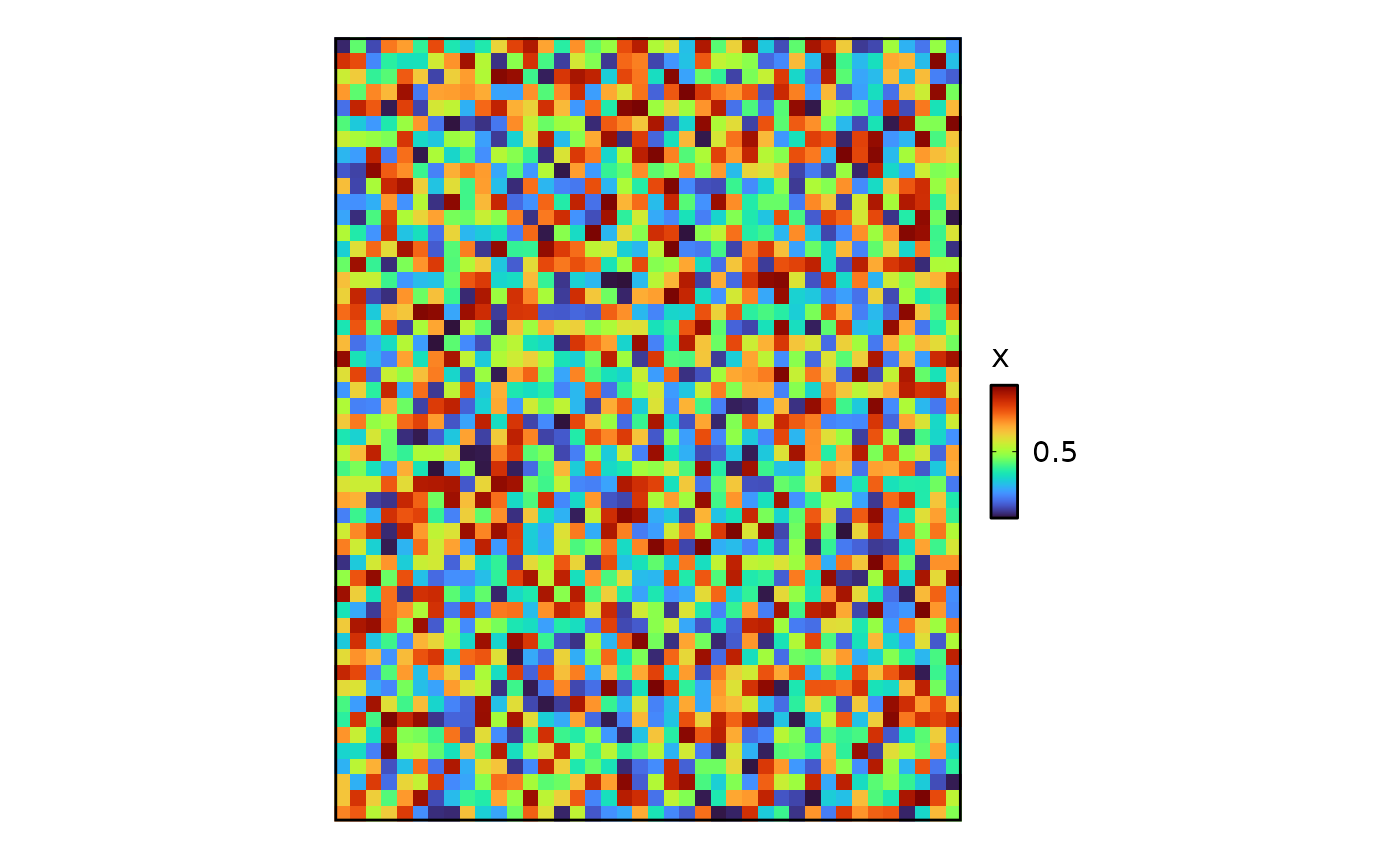 SpatImagePlot(r, raster = TRUE, raster_dpi = 20)
SpatImagePlot(r, raster = TRUE, raster_dpi = 20)
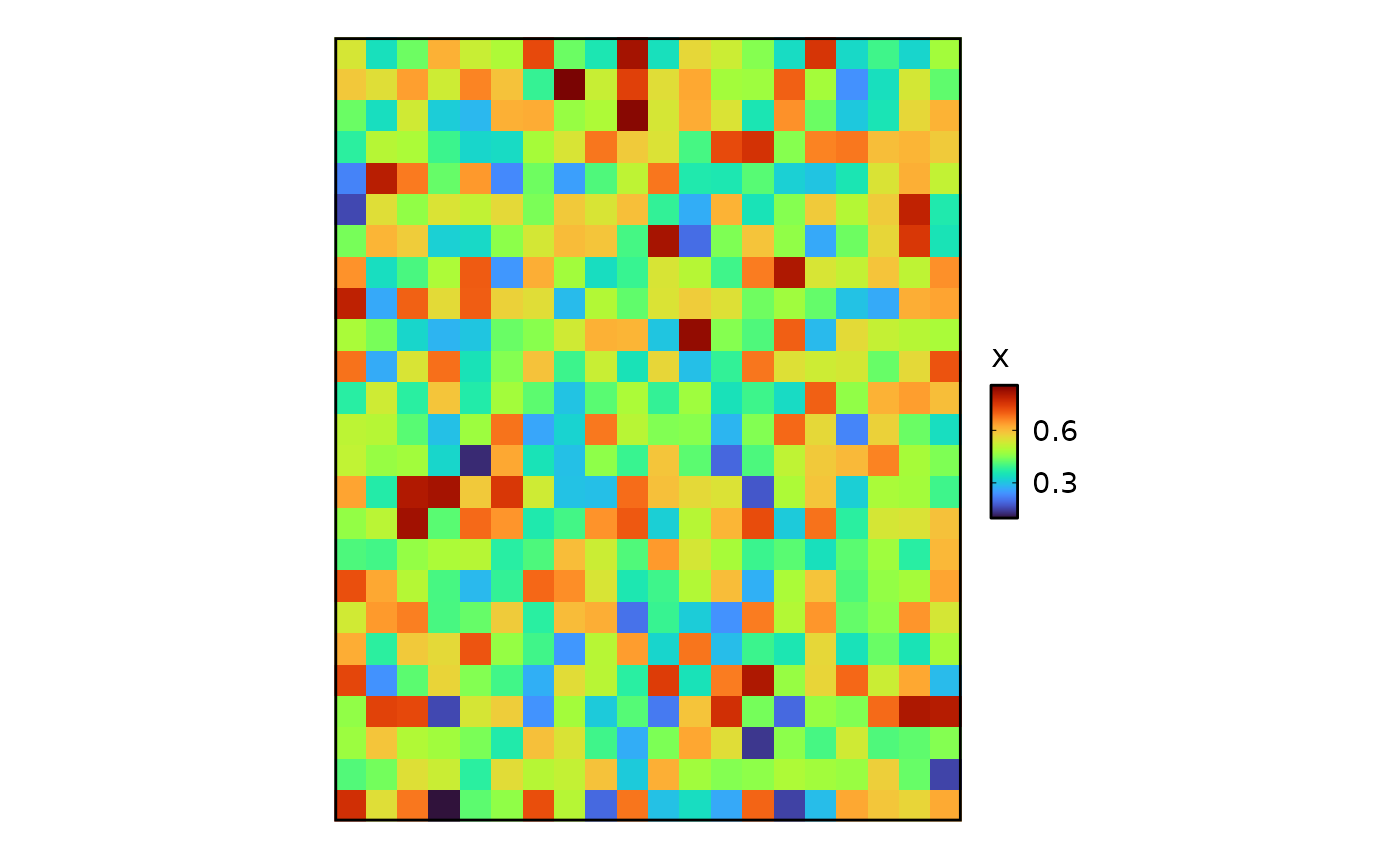 SpatImagePlot(r, alpha = 0.5, theme = "theme_blank",
theme_args = list(add_coord = FALSE), fill_name = "value")
SpatImagePlot(r, alpha = 0.5, theme = "theme_blank",
theme_args = list(add_coord = FALSE), fill_name = "value")
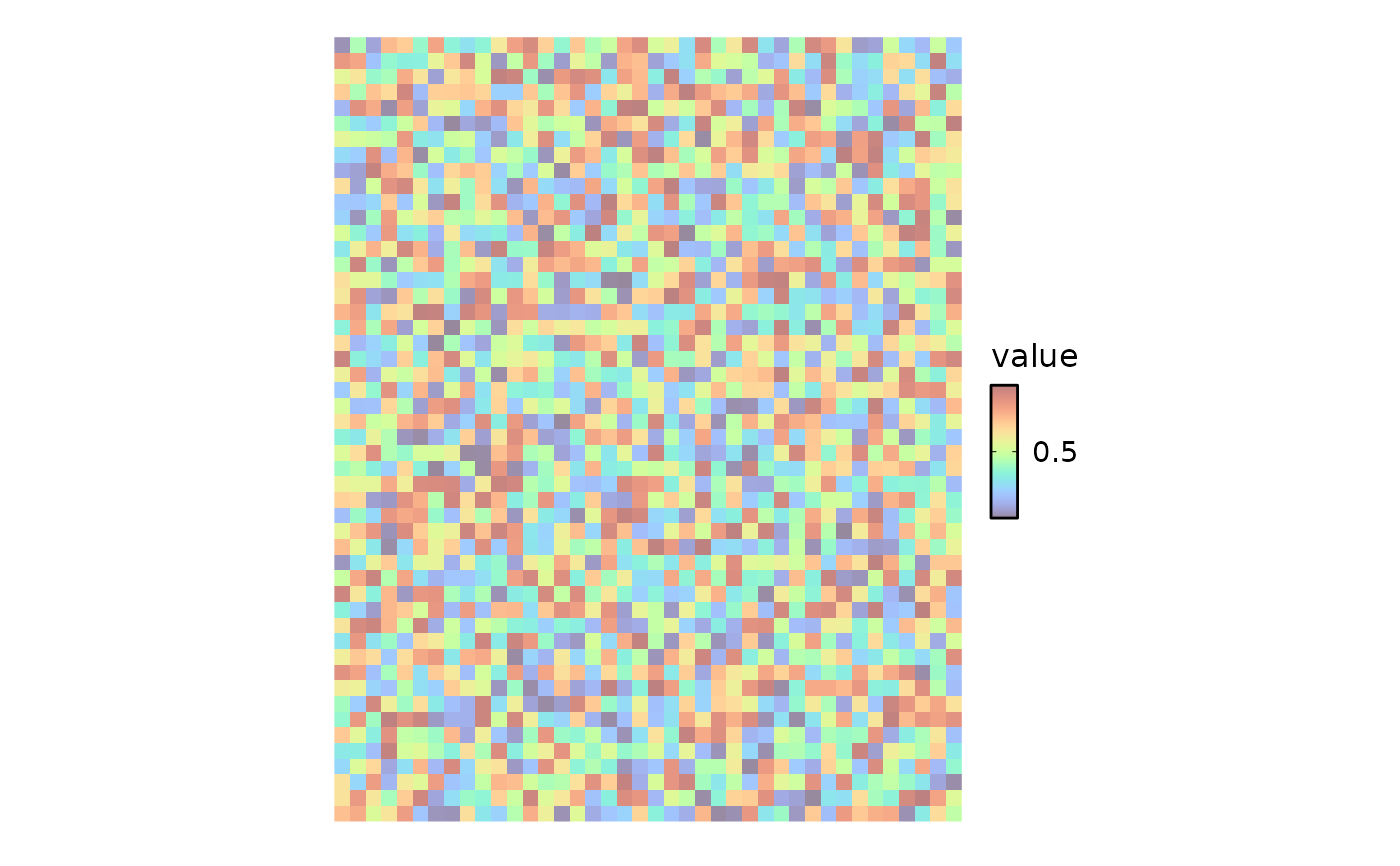 SpatImagePlot(r, ext = c(0, 10, 0, 10), flip_y = FALSE, palette = "viridis")
SpatImagePlot(r, ext = c(0, 10, 0, 10), flip_y = FALSE, palette = "viridis")
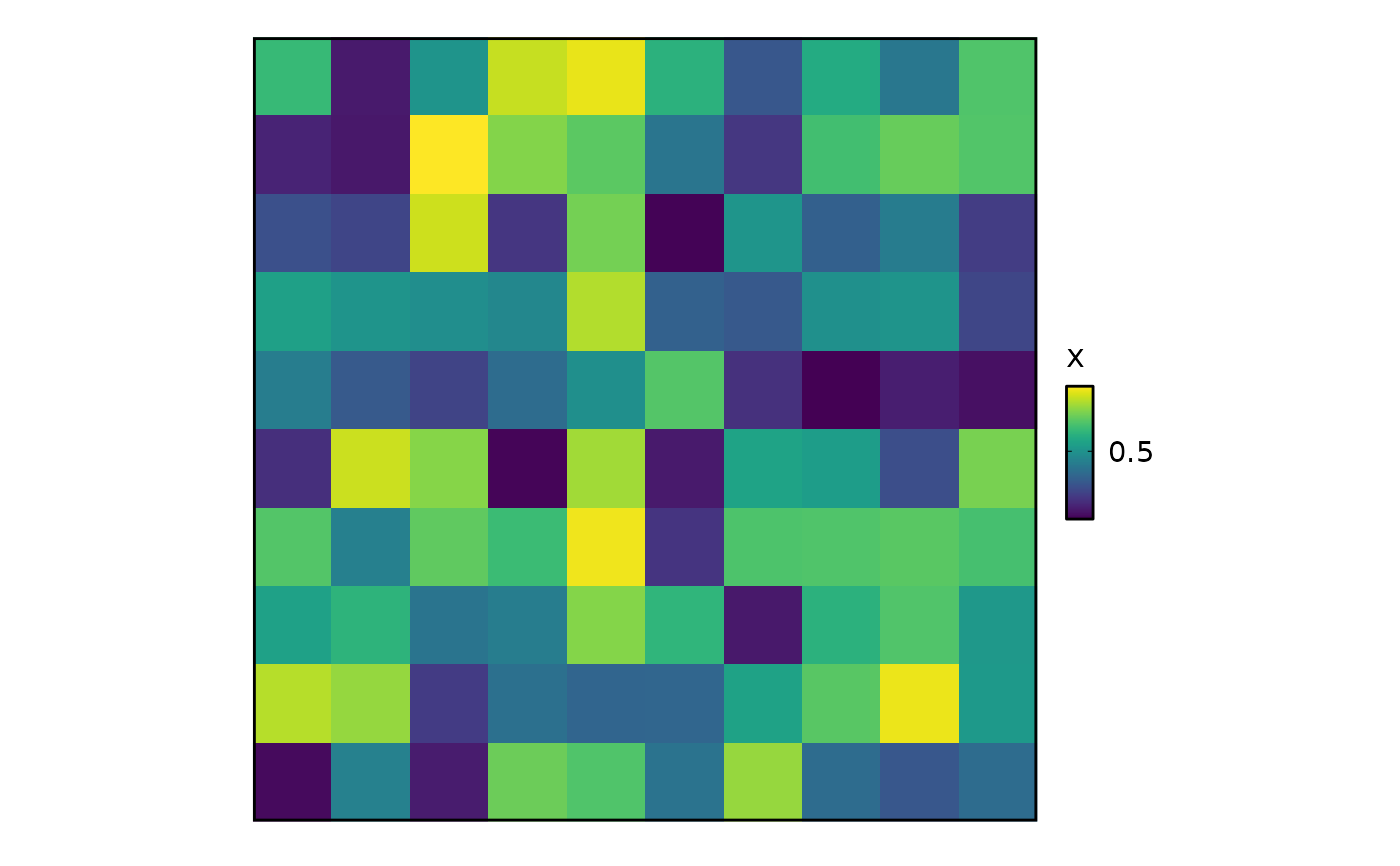 # --- SpatMasksPlot ---
m <- terra::rast(
nrows = 50, ncols = 40,
vals = sample(c(1:5, NA), 2000, replace = TRUE, prob = c(rep(0.04, 5), 0.8)),
xmin = 0, xmax = 40, ymin = 0, ymax = 50,
crs = ""
)
SpatMasksPlot(m, border_color = "red")
# --- SpatMasksPlot ---
m <- terra::rast(
nrows = 50, ncols = 40,
vals = sample(c(1:5, NA), 2000, replace = TRUE, prob = c(rep(0.04, 5), 0.8)),
xmin = 0, xmax = 40, ymin = 0, ymax = 50,
crs = ""
)
SpatMasksPlot(m, border_color = "red")
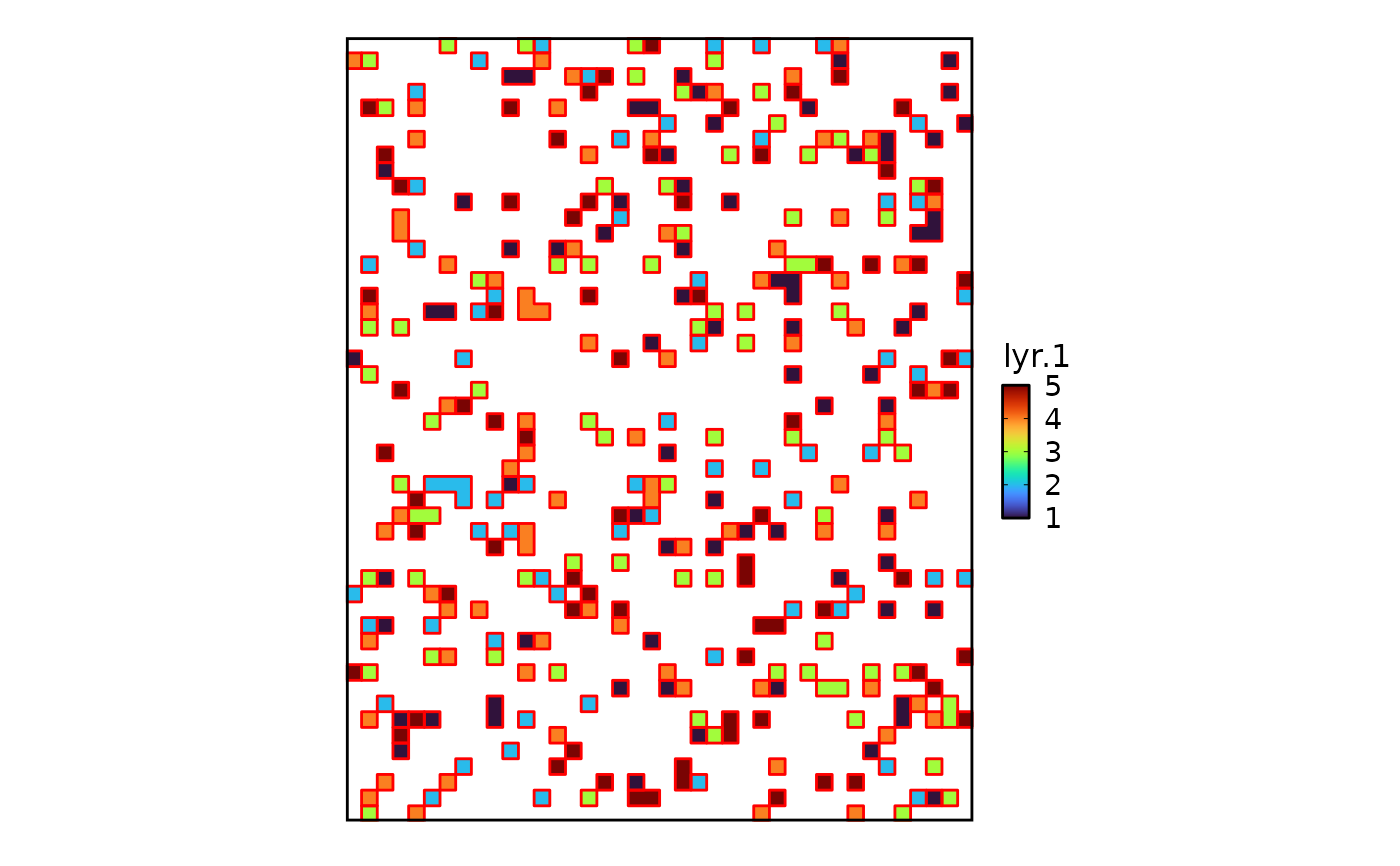 SpatMasksPlot(m, ext = c(0, 15, 0, 20), add_border = FALSE,
palette_reverse = TRUE, fill_name = "value")
#> Warning: Raster pixels are placed at uneven horizontal intervals and will be shifted
#> ℹ Consider using `geom_tile()` instead.
SpatMasksPlot(m, ext = c(0, 15, 0, 20), add_border = FALSE,
palette_reverse = TRUE, fill_name = "value")
#> Warning: Raster pixels are placed at uneven horizontal intervals and will be shifted
#> ℹ Consider using `geom_tile()` instead.
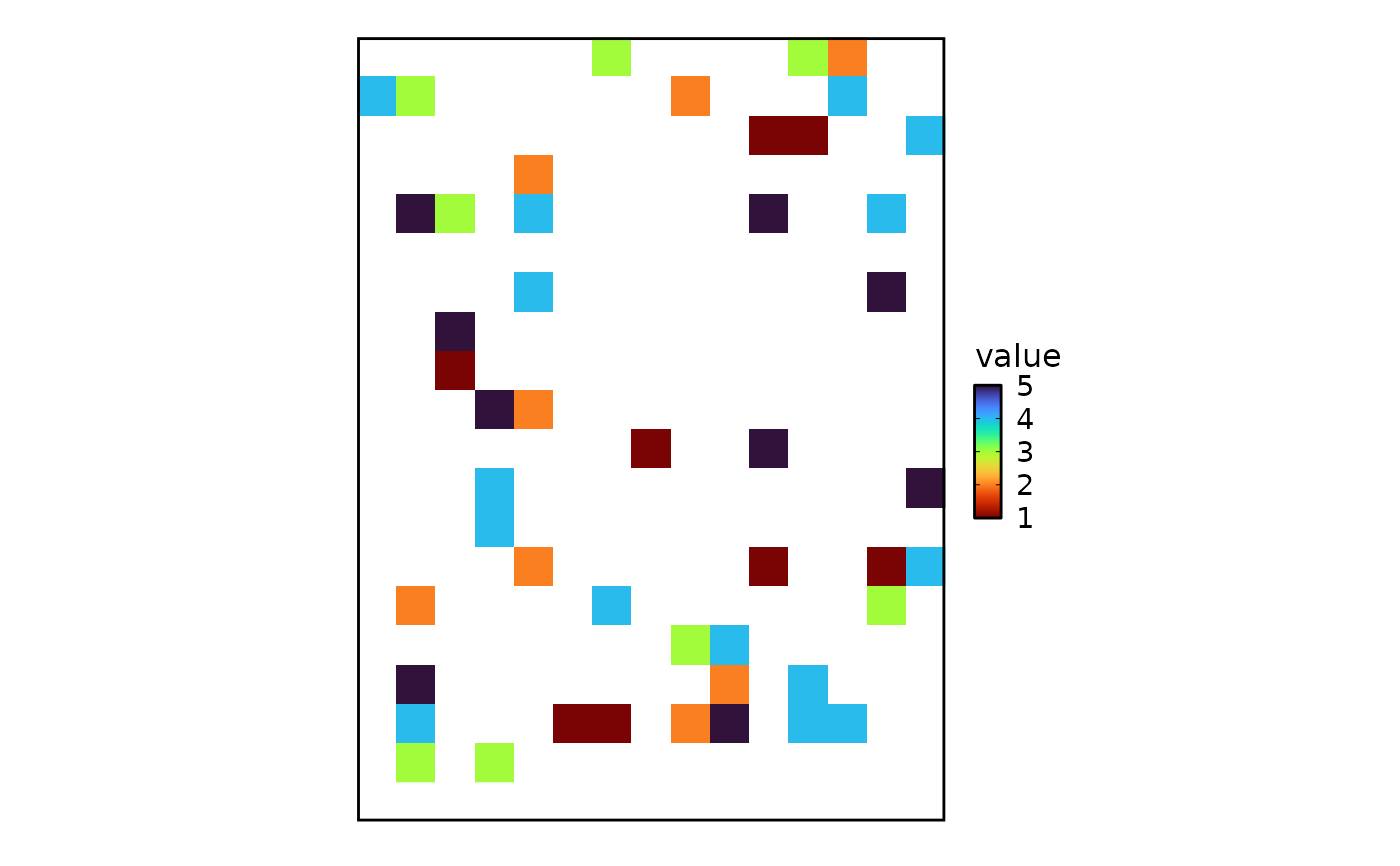 # --- SpatShapesPlot ---
polygons <- data.frame(
id = paste0("poly_", 1:10),
cat = sample(LETTERS[1:3], 10, replace = TRUE),
feat1 = rnorm(10),
feat2 = rnorm(10),
geometry = c(
'POLYGON((64.6 75.3,66.0 70.5,66.4 70.2,67.0 69.8,72.8 70.4,64.6 75.3))',
'POLYGON((56.7 63.0,52.3 65.6,48.0 63.2,51.2 55.7,57.1 59.2,56.7 63.0))',
'POLYGON((9.9 16.5,9.3 15.9,8.0 13.1,11.5 7.8,17.8 11.3,9.9 16.5))',
'POLYGON((64.9 37.2,60.3 37.4,57.6 31.7,58.9 29.3,64.0 28.1,64.9 37.2))',
'POLYGON((30.5 49.1,22.4 46.5,22.4 43.9,30.9 41.9,31.6 42.9,30.5 49.1))',
'POLYGON((78.3 57.8,70.5 61.6,71.6 52.7,72.2 52.5,77.4 54.5,78.3 57.8))',
'POLYGON((41.8 23.8,41.3 25.9,41.0 26.4,36.5 28.7,35.8 28.6,41.8 23.8))',
'POLYGON((15.7 75.9,14.2 74.4,15.7 67.5,23.0 69.8,23.4 71.7,15.7 75.9))',
'POLYGON((80.7 37.4,75.3 31.3,77.1 28.5,82.5 28.0,83.1 28.5,80.7 37.4))',
'POLYGON((15.5 37.8,14.4 38.6,7.3 32.6,8.3 30.9,15.1 30.2,15.5 37.8))'
)
)
polygons <- terra::vect(polygons, crs = "EPSG:4326", geom = "geometry")
SpatShapesPlot(polygons)
# --- SpatShapesPlot ---
polygons <- data.frame(
id = paste0("poly_", 1:10),
cat = sample(LETTERS[1:3], 10, replace = TRUE),
feat1 = rnorm(10),
feat2 = rnorm(10),
geometry = c(
'POLYGON((64.6 75.3,66.0 70.5,66.4 70.2,67.0 69.8,72.8 70.4,64.6 75.3))',
'POLYGON((56.7 63.0,52.3 65.6,48.0 63.2,51.2 55.7,57.1 59.2,56.7 63.0))',
'POLYGON((9.9 16.5,9.3 15.9,8.0 13.1,11.5 7.8,17.8 11.3,9.9 16.5))',
'POLYGON((64.9 37.2,60.3 37.4,57.6 31.7,58.9 29.3,64.0 28.1,64.9 37.2))',
'POLYGON((30.5 49.1,22.4 46.5,22.4 43.9,30.9 41.9,31.6 42.9,30.5 49.1))',
'POLYGON((78.3 57.8,70.5 61.6,71.6 52.7,72.2 52.5,77.4 54.5,78.3 57.8))',
'POLYGON((41.8 23.8,41.3 25.9,41.0 26.4,36.5 28.7,35.8 28.6,41.8 23.8))',
'POLYGON((15.7 75.9,14.2 74.4,15.7 67.5,23.0 69.8,23.4 71.7,15.7 75.9))',
'POLYGON((80.7 37.4,75.3 31.3,77.1 28.5,82.5 28.0,83.1 28.5,80.7 37.4))',
'POLYGON((15.5 37.8,14.4 38.6,7.3 32.6,8.3 30.9,15.1 30.2,15.5 37.8))'
)
)
polygons <- terra::vect(polygons, crs = "EPSG:4326", geom = "geometry")
SpatShapesPlot(polygons)
 SpatShapesPlot(polygons, ext = c(0, 20, 0, 20))
SpatShapesPlot(polygons, ext = c(0, 20, 0, 20))
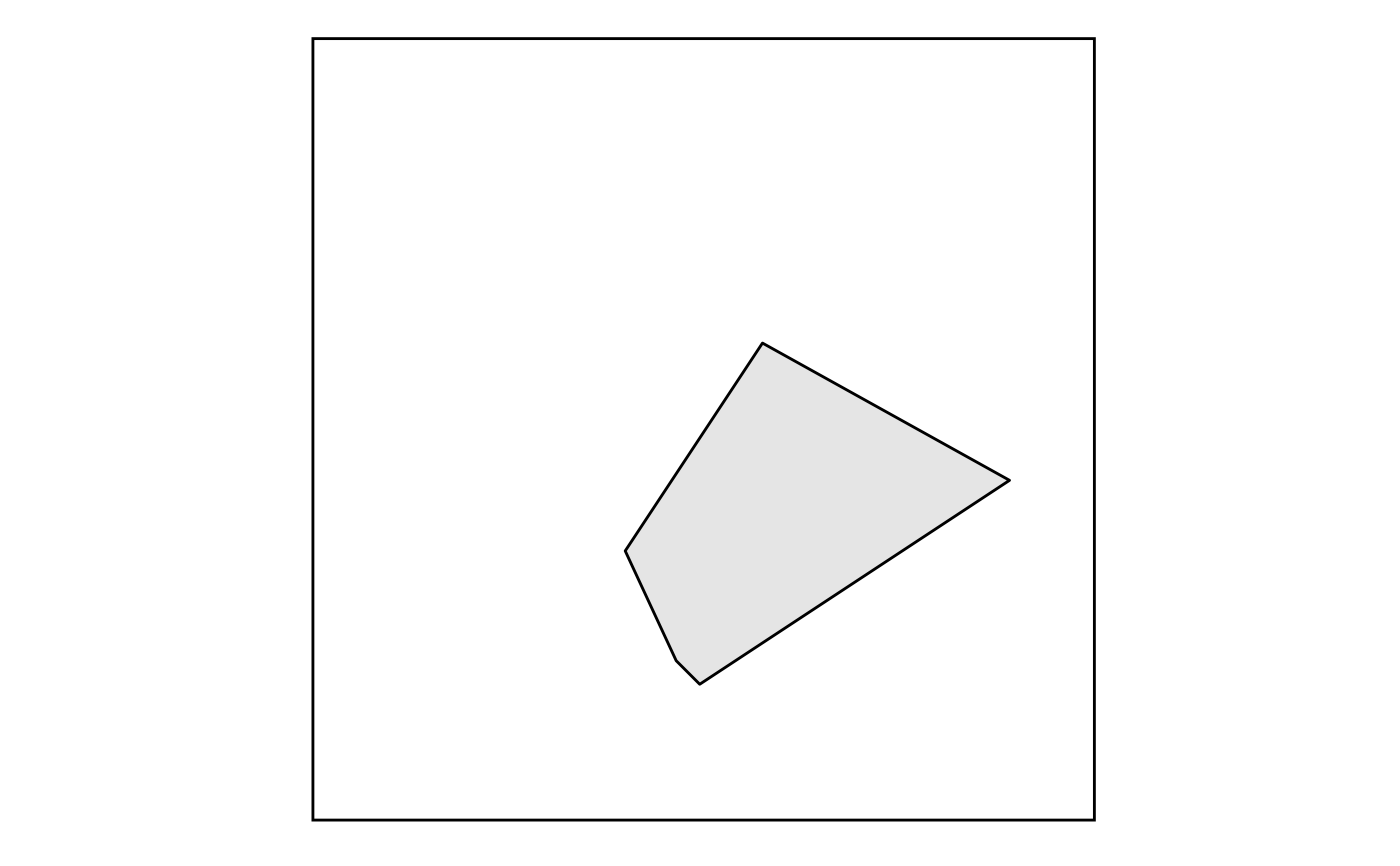 SpatShapesPlot(polygons, highlight = 'cat == "A"', highlight_color = "red2")
SpatShapesPlot(polygons, highlight = 'cat == "A"', highlight_color = "red2")
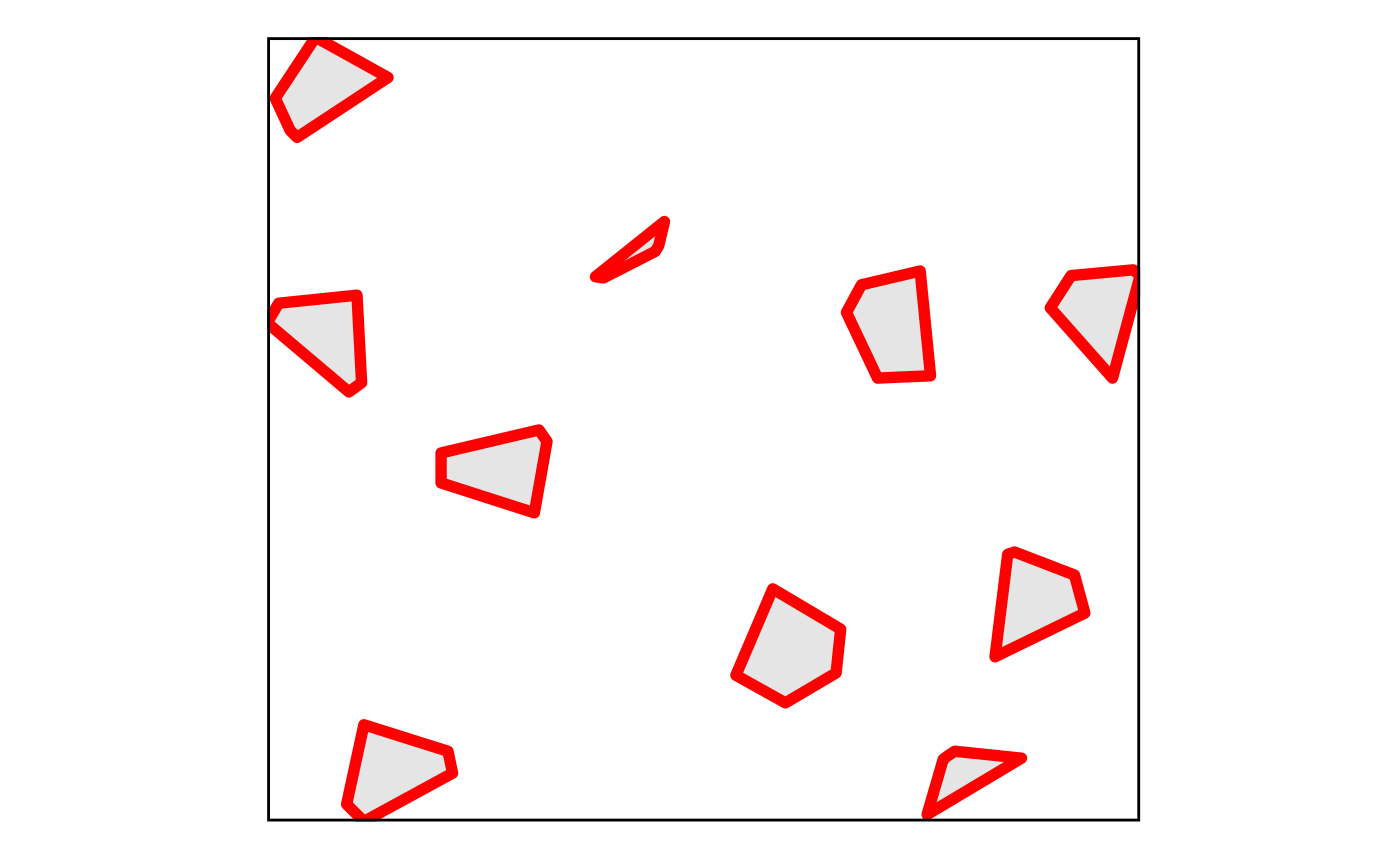 SpatShapesPlot(polygons, border_color = "red", border_size = 2)
SpatShapesPlot(polygons, border_color = "red", border_size = 2)
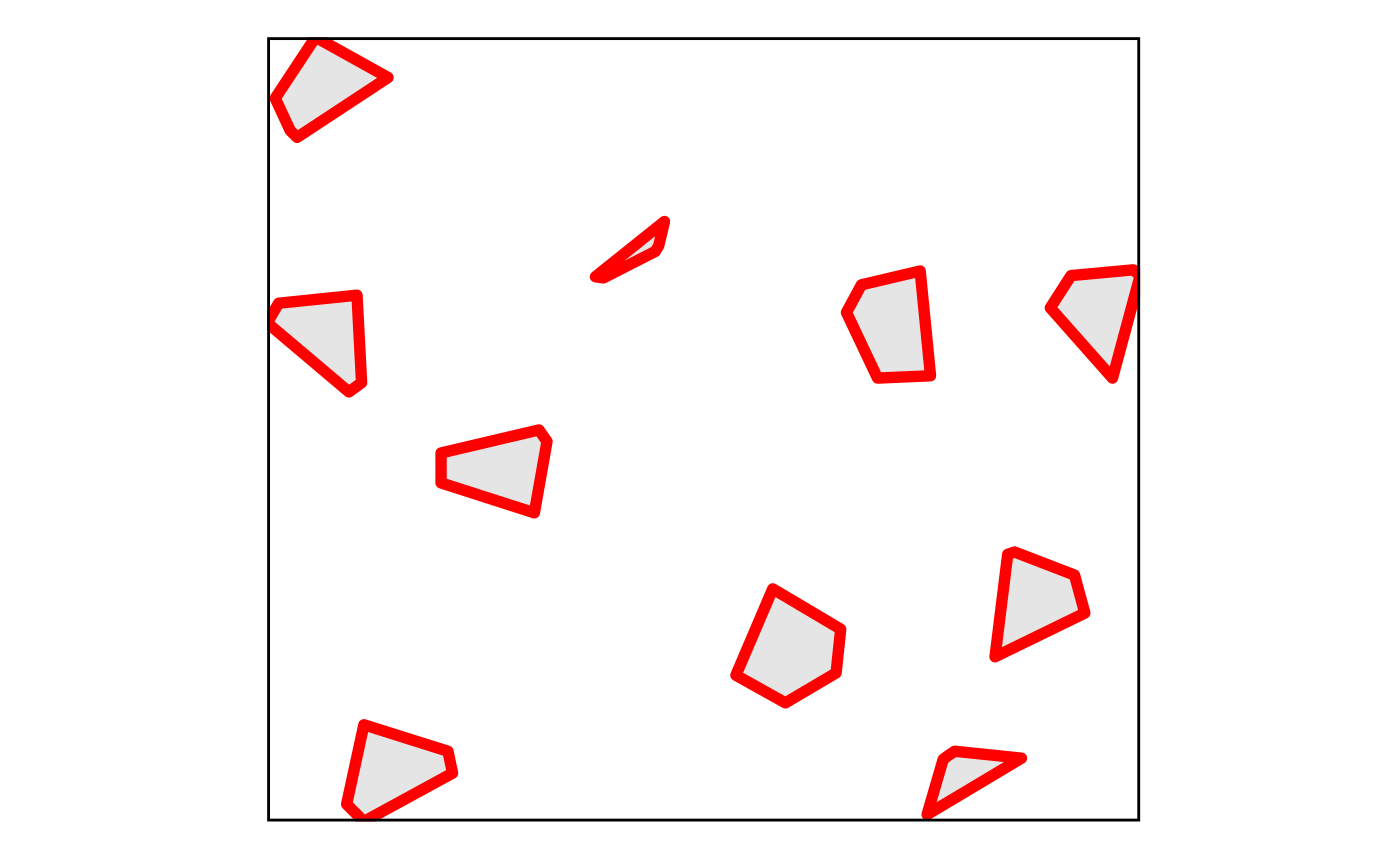 SpatShapesPlot(polygons, fill_by = "cat", fill_name = "category")
SpatShapesPlot(polygons, fill_by = "cat", fill_name = "category")
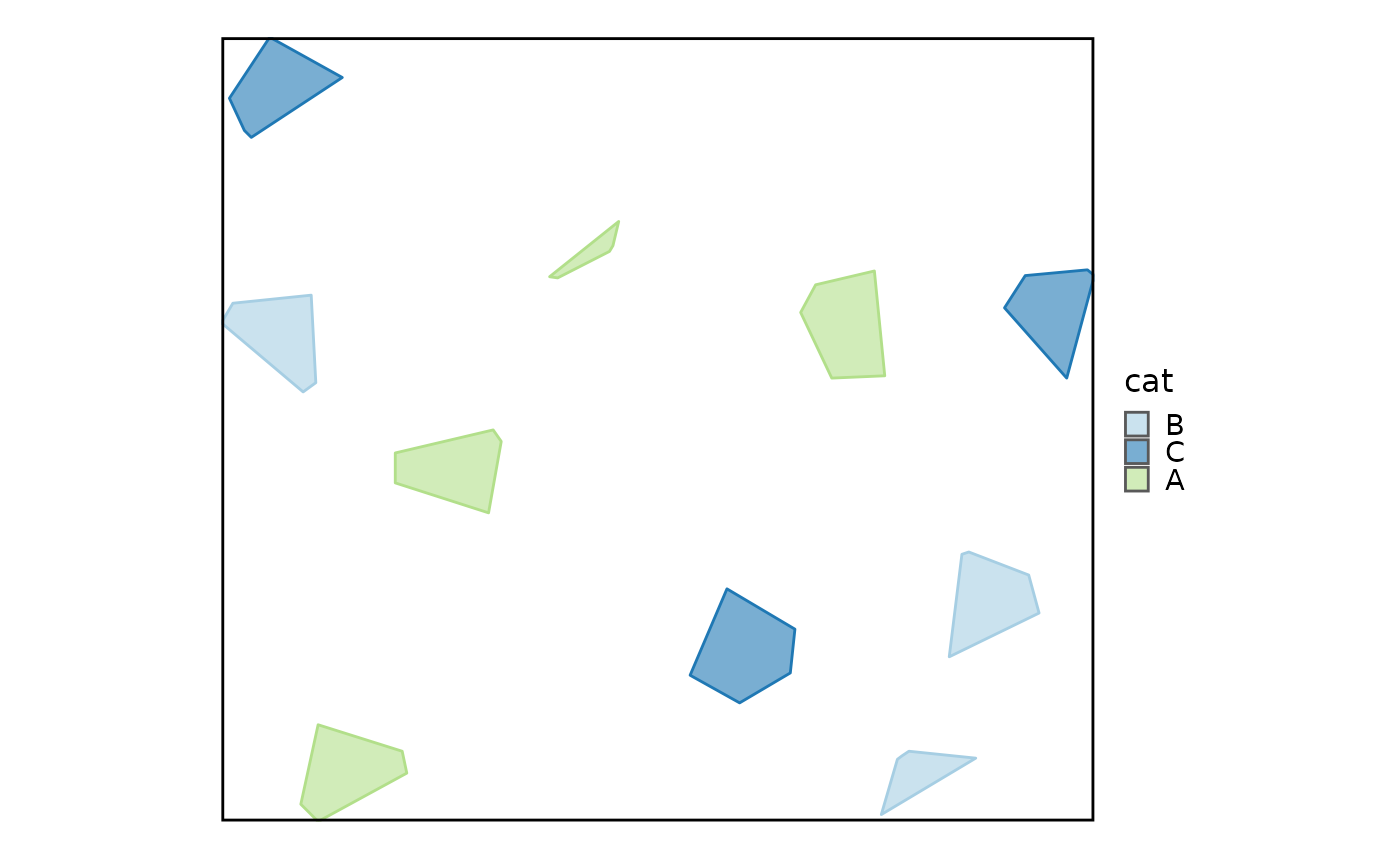 # Let border color be determined by fill
SpatShapesPlot(polygons, fill_by = "cat", alpha = 0.6, border_color = TRUE)
# Let border color be determined by fill
SpatShapesPlot(polygons, fill_by = "cat", alpha = 0.6, border_color = TRUE)
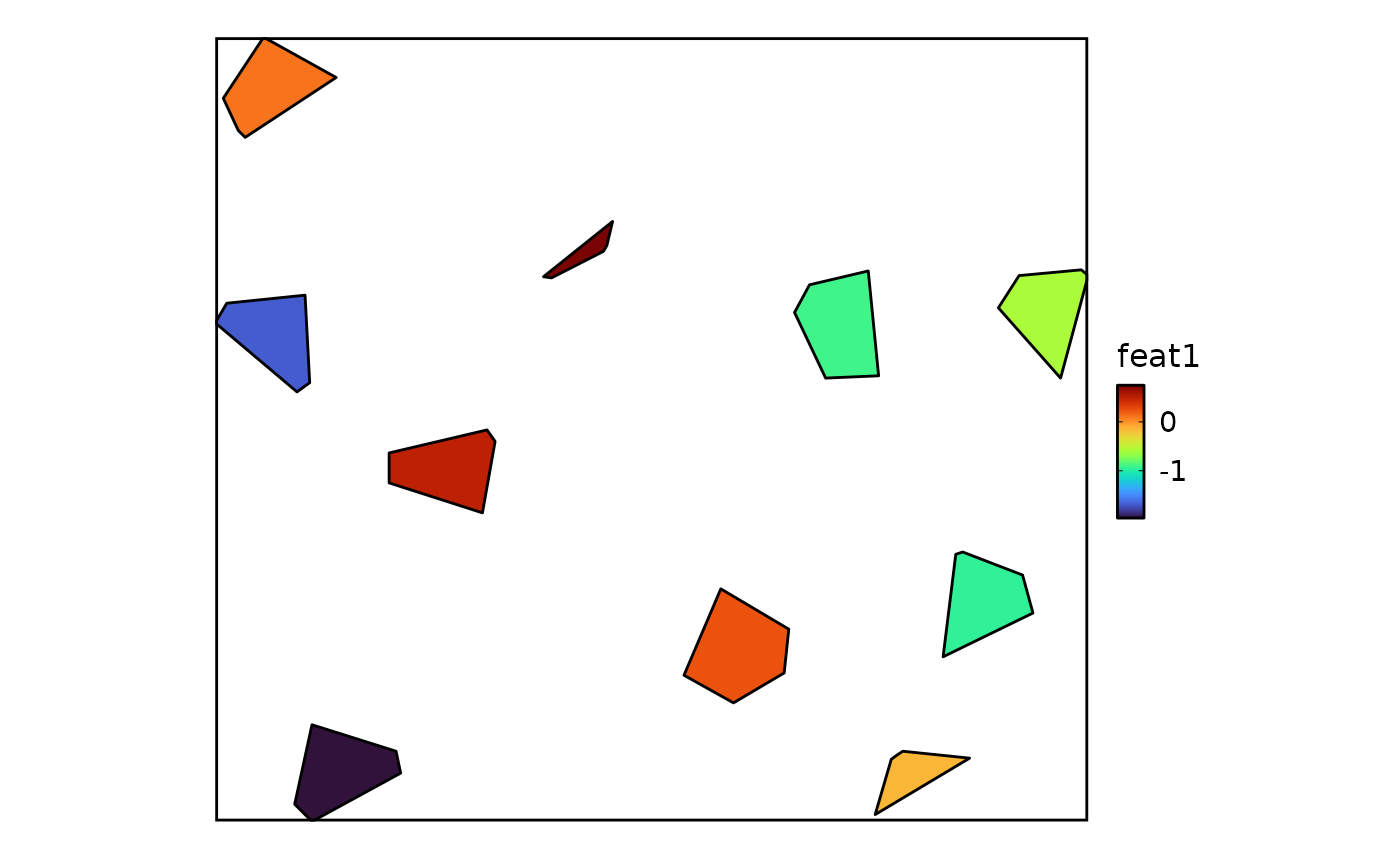 SpatShapesPlot(polygons, fill_by = "feat1")
SpatShapesPlot(polygons, fill_by = "feat1")
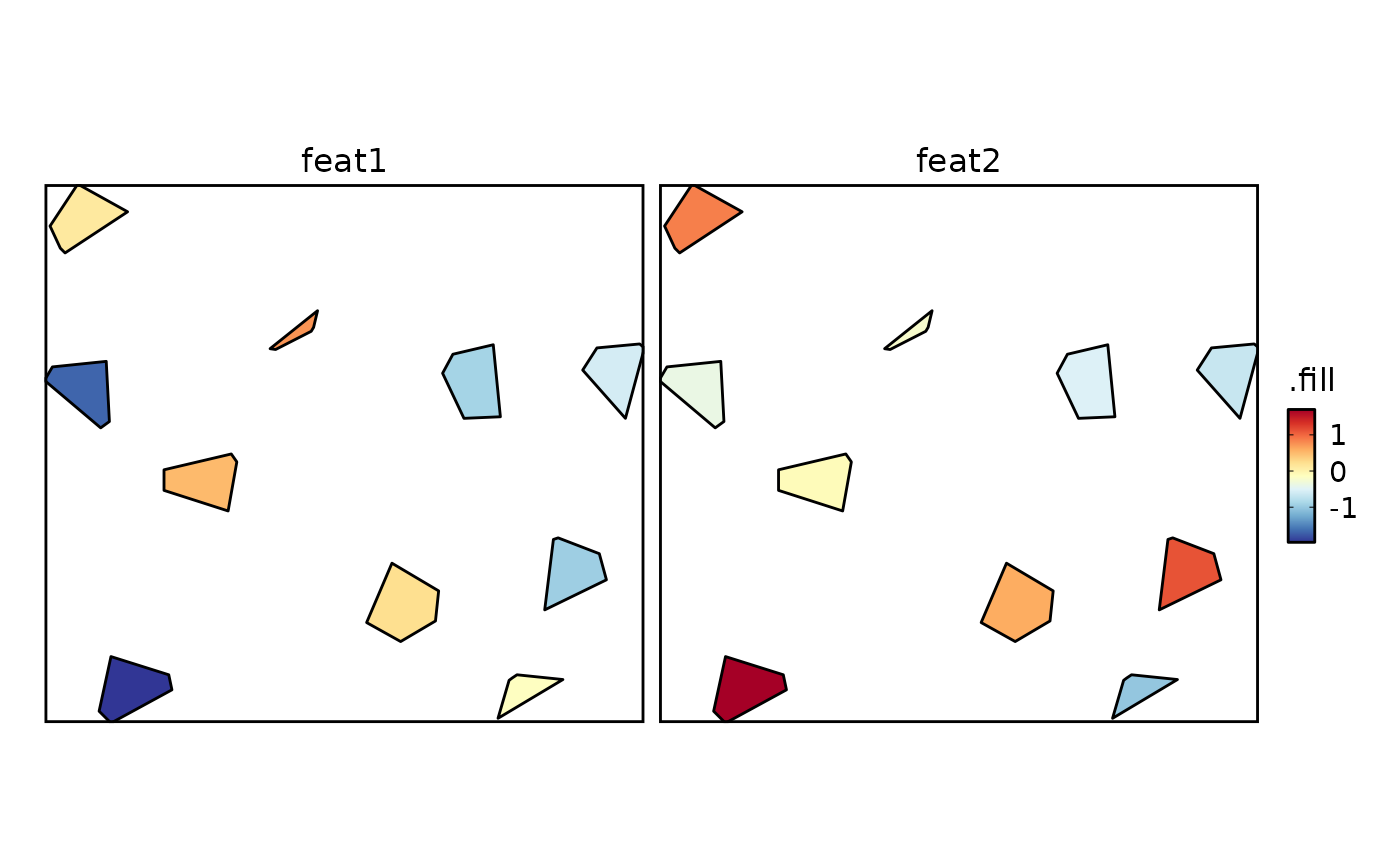 SpatShapesPlot(polygons, fill_by = c("feat1", "feat2"), palette = "RdYlBu")
SpatShapesPlot(polygons, fill_by = c("feat1", "feat2"), palette = "RdYlBu")
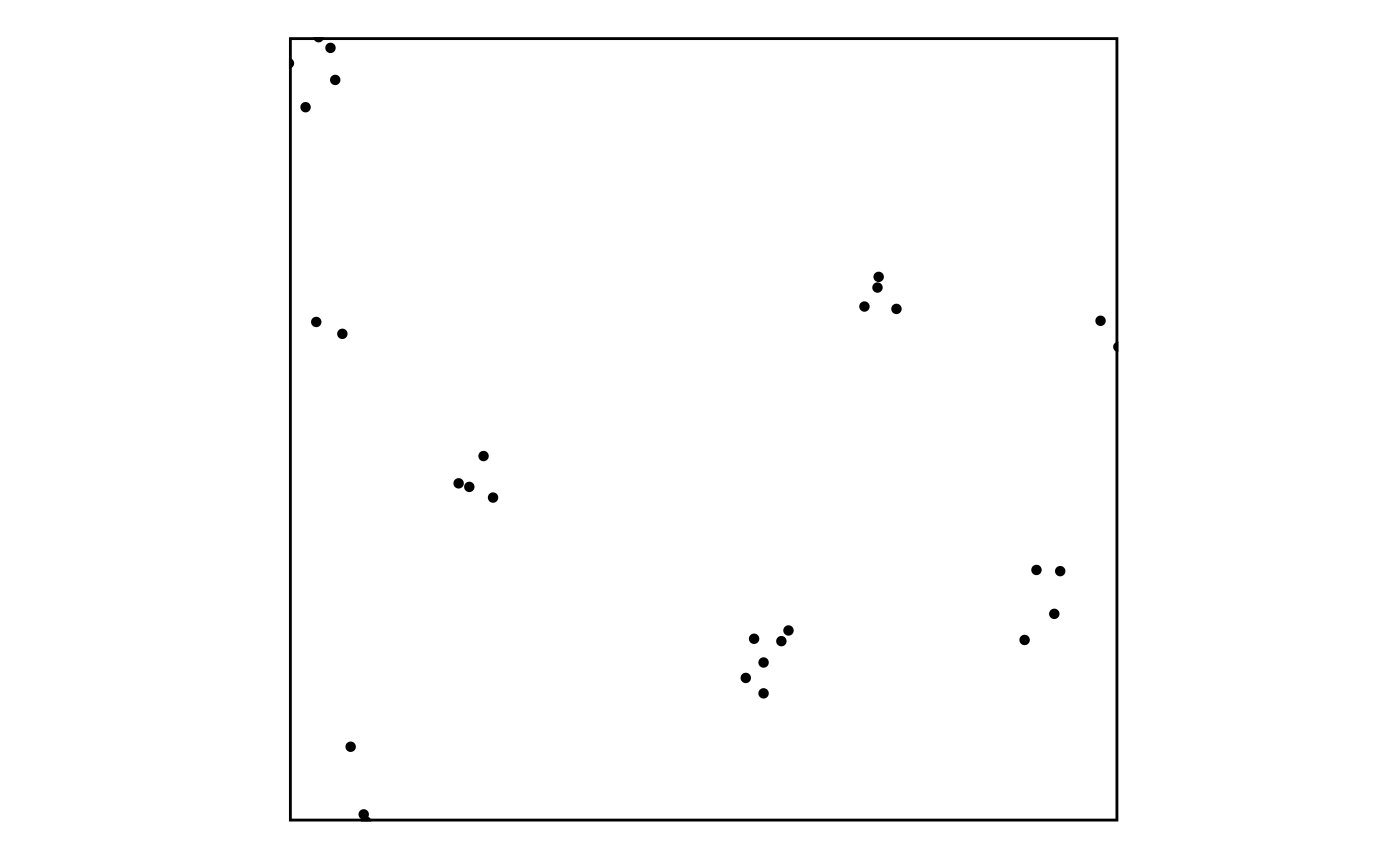 # --- SpatPointsPlot ---
# create some random points in the above polygons
points <- data.frame(
id = paste0("point_", 1:30),
gene = sample(LETTERS[1:3], 30, replace = TRUE),
feat1 = runif(30, 0, 100),
feat2 = runif(30, 0, 100),
size = runif(30, 1, 5),
x = c(
61.6, 14.3, 12.7, 49.6, 74.9, 58.9, 13.9, 24.7, 16.9, 15.6,
72.4, 60.1, 75.4, 14.9, 80.3, 78.8, 16.7, 27.6, 48.9, 52.5,
12.9, 11.8, 50.4, 25.6, 10.4, 51.9, 73.4, 26.8, 50.4, 60.0
),
y = c(
32.1, 12.8, 33.2, 59.9, 57.8, 31.9, 10.1, 46.8, 75.3, 69.0,
60.0, 29.4, 54.2, 34.2, 35.3, 33.1, 74.7, 48.0, 63.2, 59.2,
9.2, 15.1, 64.5, 47.1, 11.4, 60.1, 54.1, 44.5, 61.9, 30.3
)
)
SpatPointsPlot(points)
# --- SpatPointsPlot ---
# create some random points in the above polygons
points <- data.frame(
id = paste0("point_", 1:30),
gene = sample(LETTERS[1:3], 30, replace = TRUE),
feat1 = runif(30, 0, 100),
feat2 = runif(30, 0, 100),
size = runif(30, 1, 5),
x = c(
61.6, 14.3, 12.7, 49.6, 74.9, 58.9, 13.9, 24.7, 16.9, 15.6,
72.4, 60.1, 75.4, 14.9, 80.3, 78.8, 16.7, 27.6, 48.9, 52.5,
12.9, 11.8, 50.4, 25.6, 10.4, 51.9, 73.4, 26.8, 50.4, 60.0
),
y = c(
32.1, 12.8, 33.2, 59.9, 57.8, 31.9, 10.1, 46.8, 75.3, 69.0,
60.0, 29.4, 54.2, 34.2, 35.3, 33.1, 74.7, 48.0, 63.2, 59.2,
9.2, 15.1, 64.5, 47.1, 11.4, 60.1, 54.1, 44.5, 61.9, 30.3
)
)
SpatPointsPlot(points)
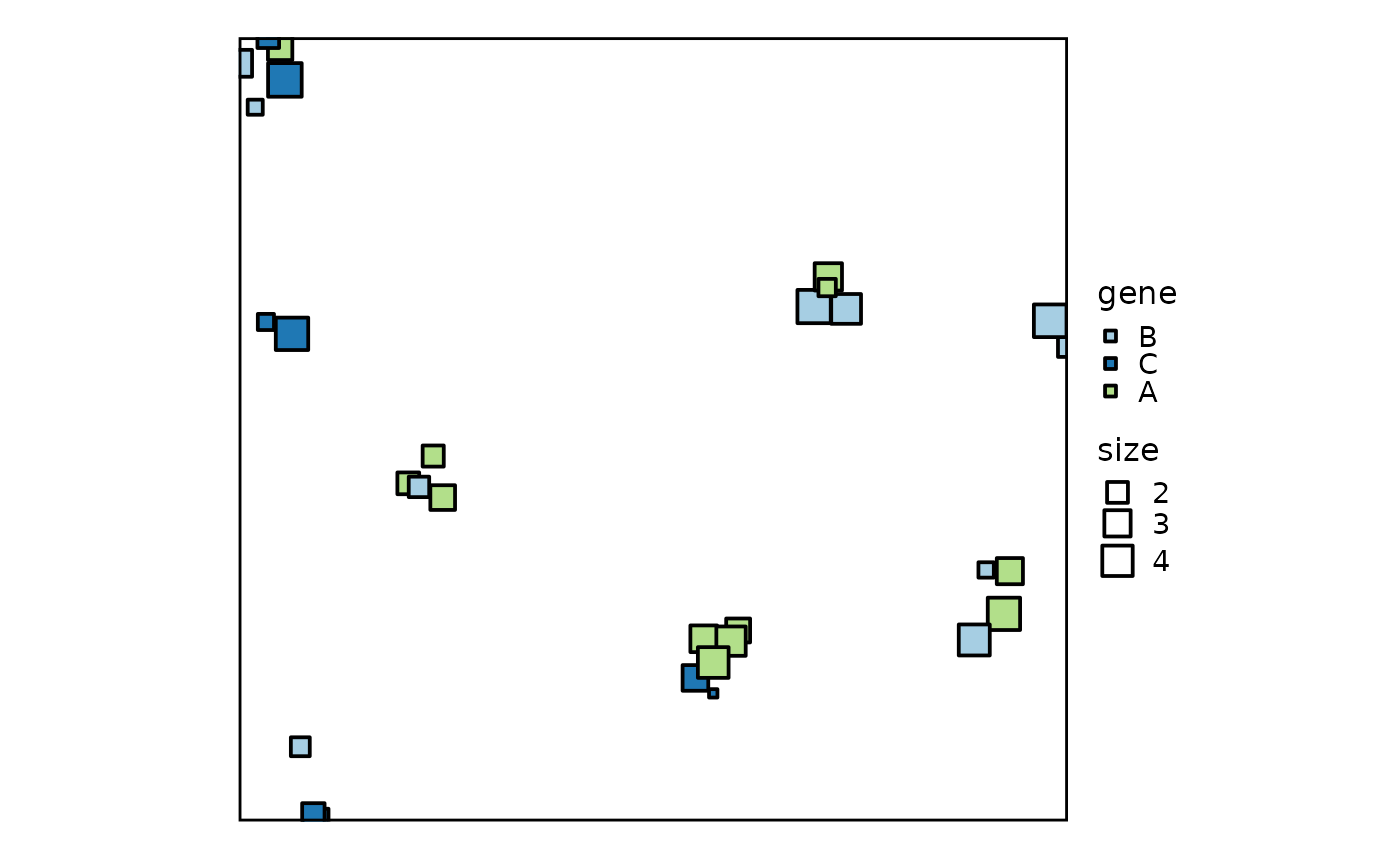 SpatPointsPlot(points, color_by = "gene", size_by = "size", shape = 22,
border_size = 1)
SpatPointsPlot(points, color_by = "gene", size_by = "size", shape = 22,
border_size = 1)
 SpatPointsPlot(points, raster = TRUE, raster_dpi = 30, color_by = "feat1")
SpatPointsPlot(points, raster = TRUE, raster_dpi = 30, color_by = "feat1")
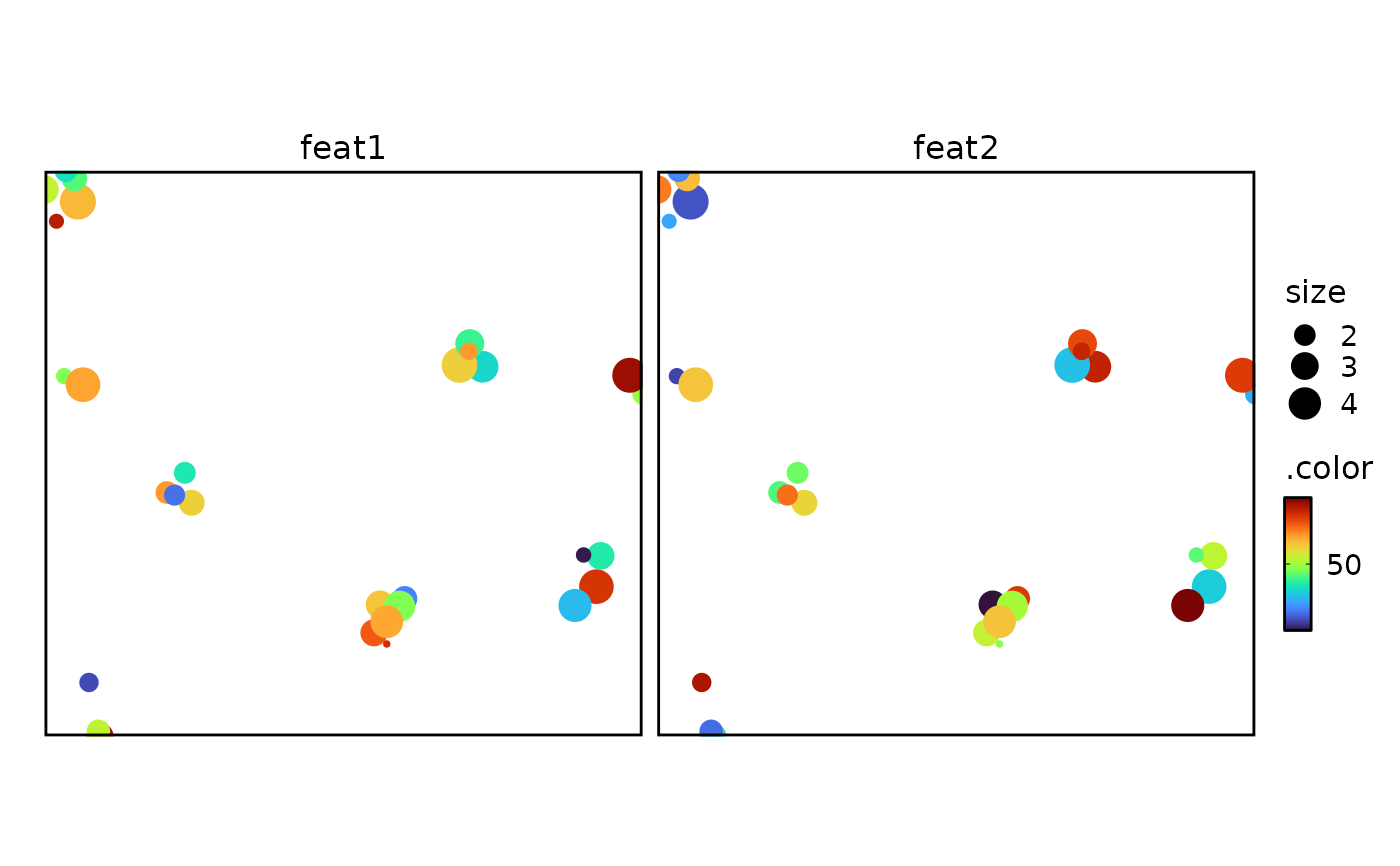 SpatPointsPlot(points, color_by = c("feat1", "feat2"), size_by = "size")
SpatPointsPlot(points, color_by = c("feat1", "feat2"), size_by = "size")
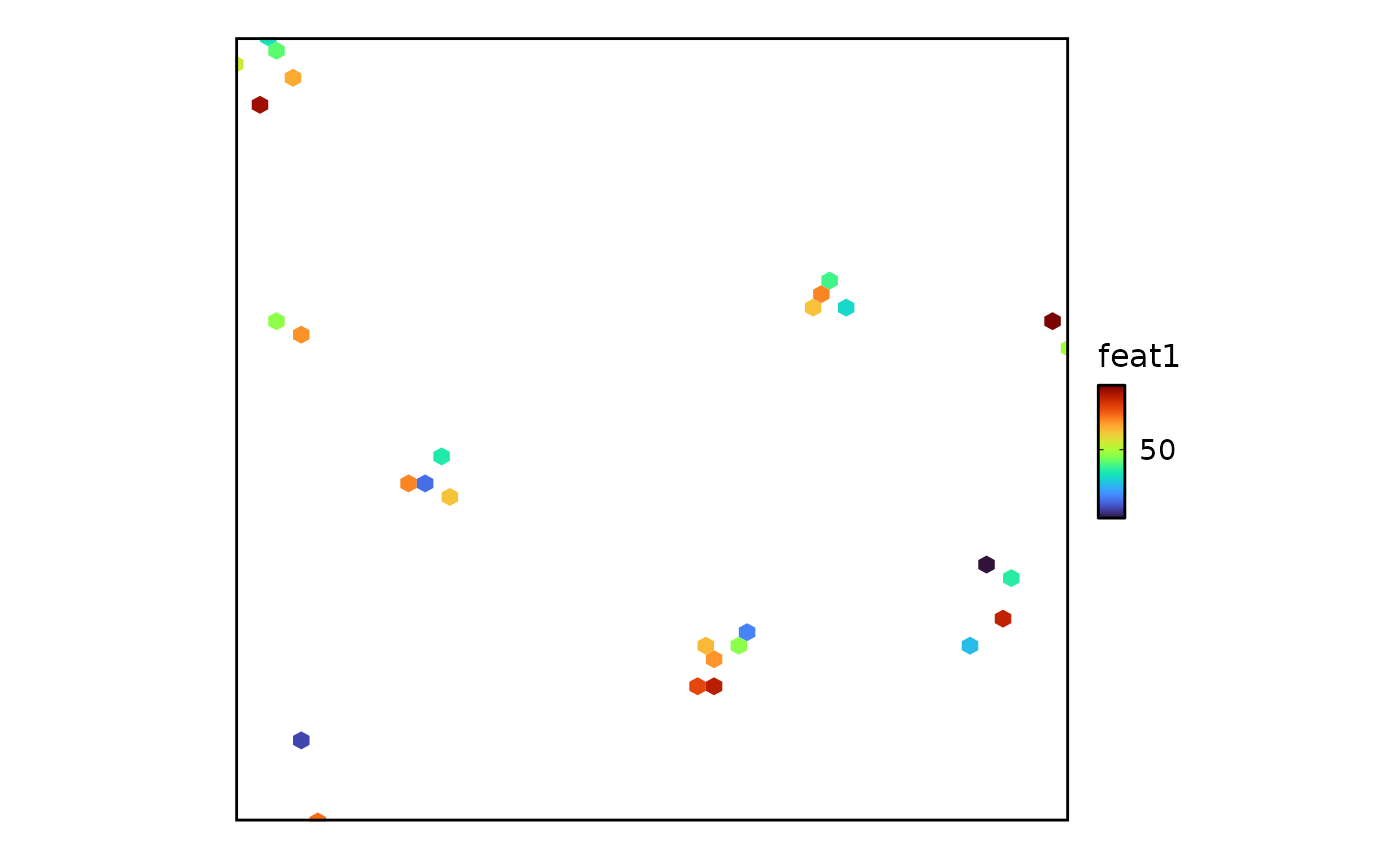 SpatPointsPlot(points, color_by = "feat1", upper_cutoff = 50)
SpatPointsPlot(points, color_by = "feat1", upper_cutoff = 50)
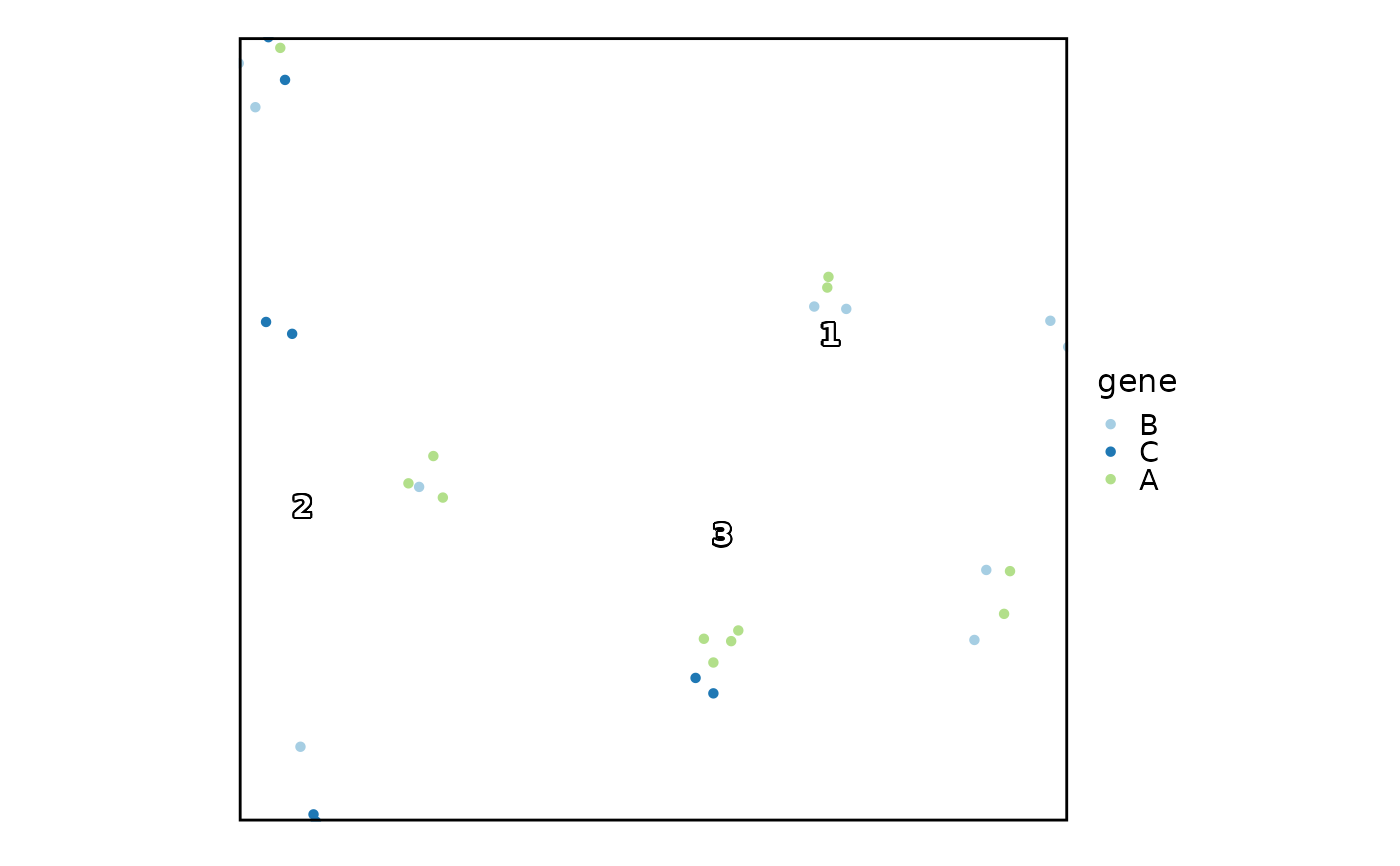 SpatPointsPlot(points, color_by = "feat1", hex = TRUE)
SpatPointsPlot(points, color_by = "feat1", hex = TRUE)
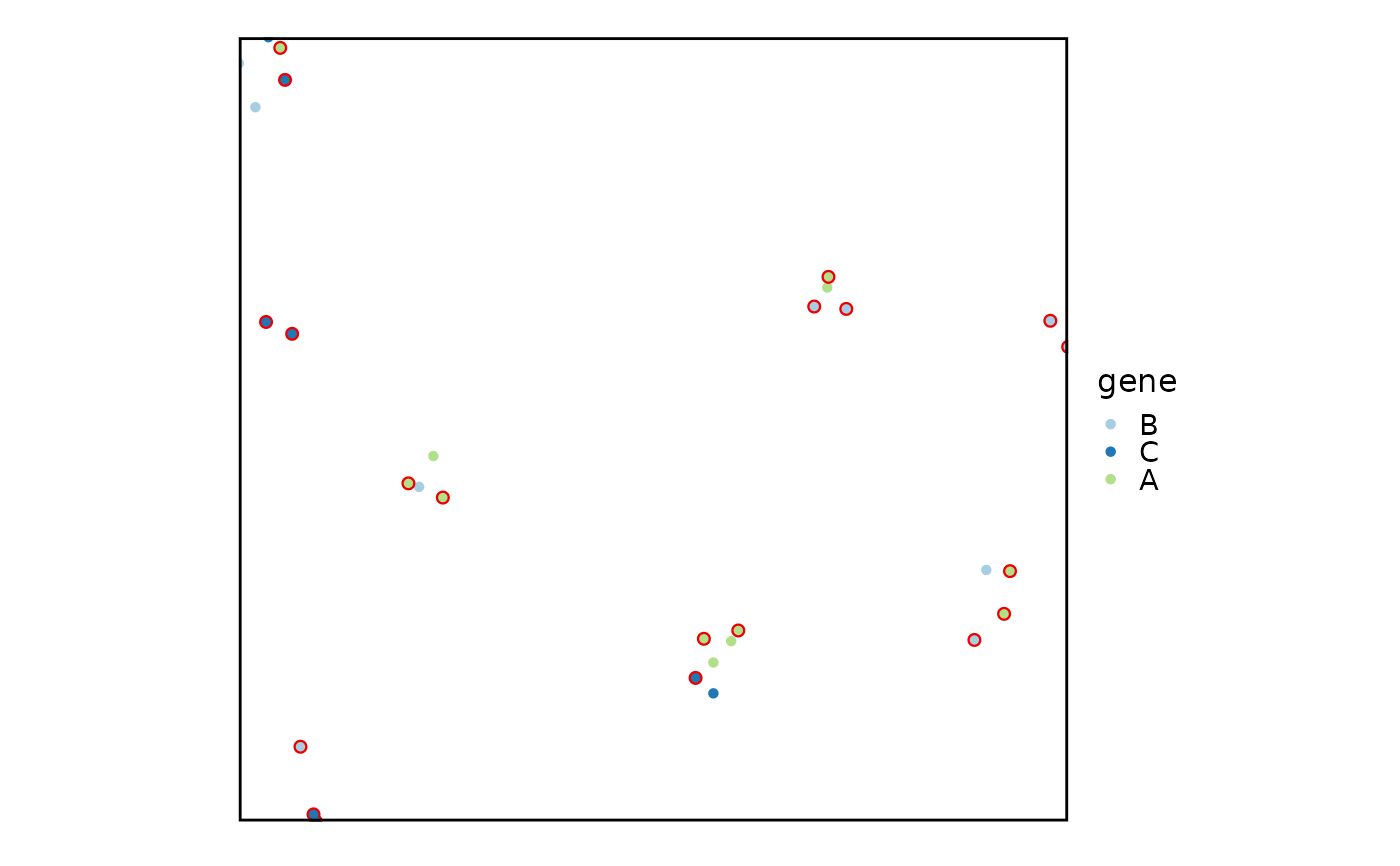 SpatPointsPlot(points, color_by = "gene", label = TRUE)
SpatPointsPlot(points, color_by = "gene", label = TRUE)
 SpatPointsPlot(points, color_by = "gene", highlight = 1:20,
highlight_color = "red2", highlight_stroke = 0.8)
SpatPointsPlot(points, color_by = "gene", highlight = 1:20,
highlight_color = "red2", highlight_stroke = 0.8)
 # --- Graph/Network functionality ---
# Create a simple adjacency matrix for demonstration
set.seed(8525)
graph_mat <- matrix(0, nrow = 30, ncol = 30)
# Add some random connections with weights
for(i in 1:30) {
neighbors <- sample(setdiff(1:30, i), size = sample(2:5, 1))
graph_mat[i, neighbors] <- runif(length(neighbors), 0.1, 1)
}
rownames(graph_mat) <- colnames(graph_mat) <- rownames(points)
attr(points, "graph") <- graph_mat
SpatPointsPlot(points, color_by = "gene", graph = "@graph",
edge_color = "grey60", edge_alpha = 0.3)
# --- Graph/Network functionality ---
# Create a simple adjacency matrix for demonstration
set.seed(8525)
graph_mat <- matrix(0, nrow = 30, ncol = 30)
# Add some random connections with weights
for(i in 1:30) {
neighbors <- sample(setdiff(1:30, i), size = sample(2:5, 1))
graph_mat[i, neighbors] <- runif(length(neighbors), 0.1, 1)
}
rownames(graph_mat) <- colnames(graph_mat) <- rownames(points)
attr(points, "graph") <- graph_mat
SpatPointsPlot(points, color_by = "gene", graph = "@graph",
edge_color = "grey60", edge_alpha = 0.3)
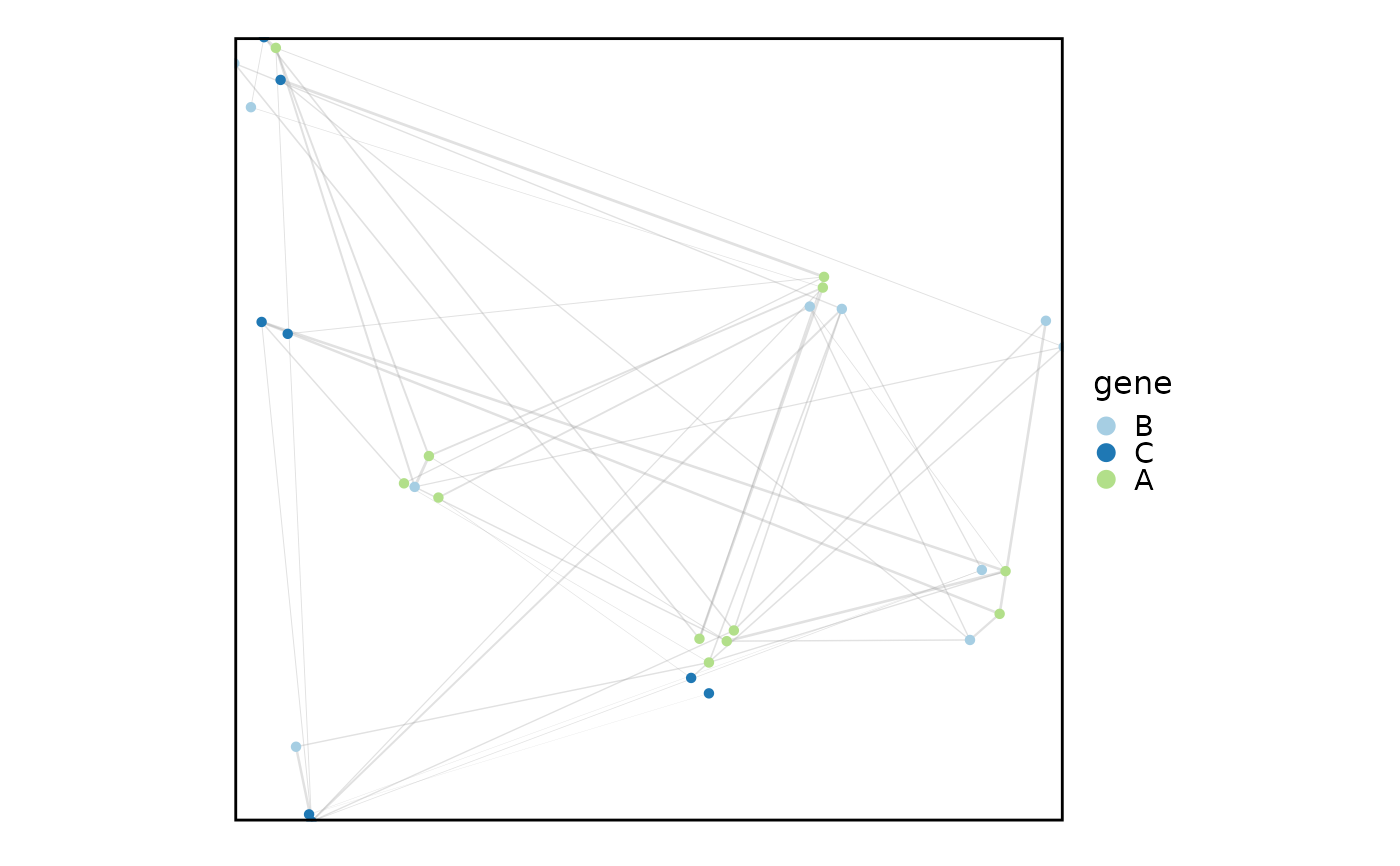 SpatPointsPlot(points, color_by = "feat1", graph = graph_mat,
edge_size = c(0.1, 1), edge_alpha = 0.5)
SpatPointsPlot(points, color_by = "feat1", graph = graph_mat,
edge_size = c(0.1, 1), edge_alpha = 0.5)
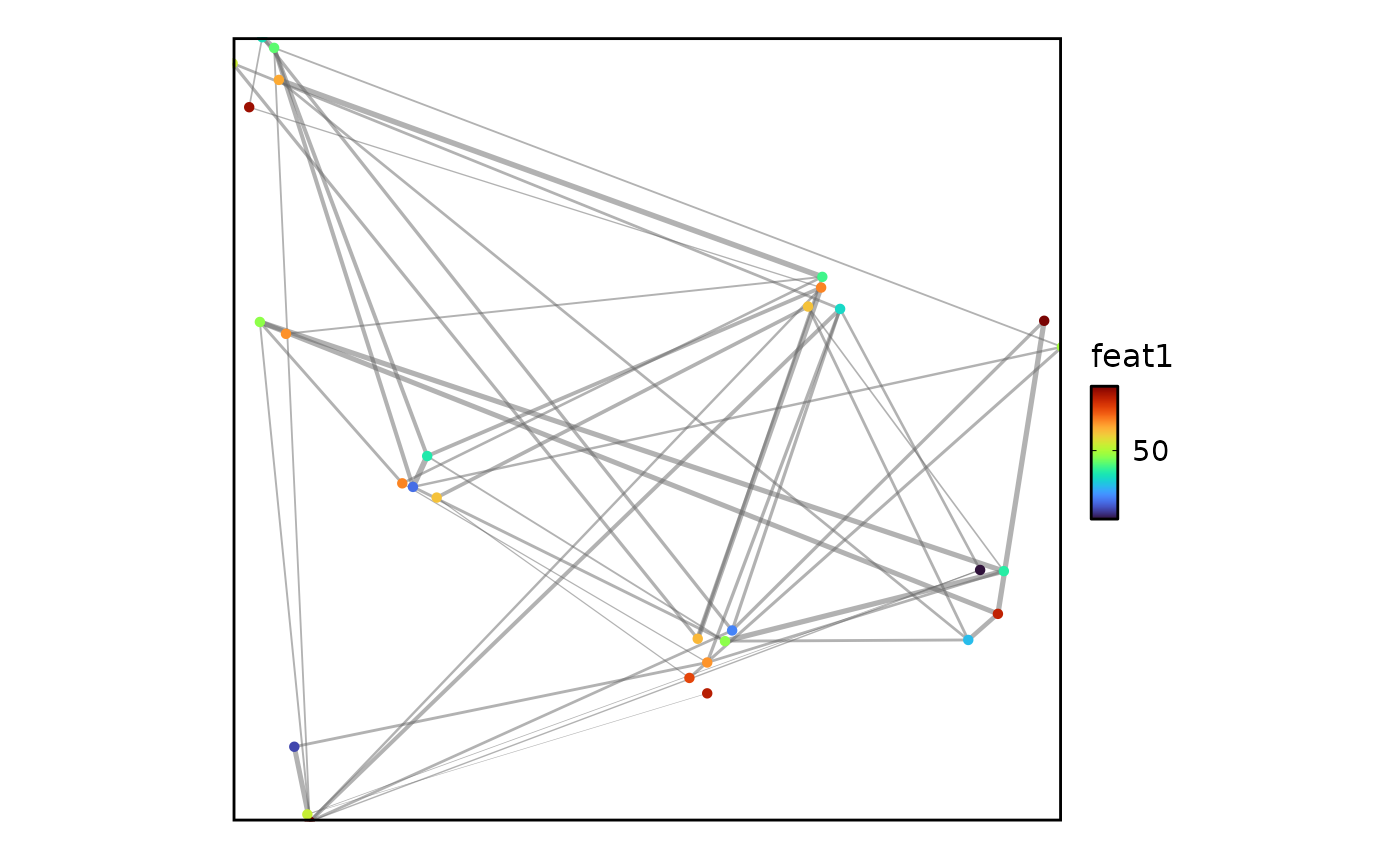 # --- Use the `return_layer` argument to get the ggplot layers
ext = c(0, 40, 0, 50)
ggplot2::ggplot() +
SpatImagePlot(r, return_layer = TRUE, alpha = 0.2, ext = ext) +
SpatShapesPlot(polygons, return_layer = TRUE, ext = ext, fill_by = "white") +
SpatPointsPlot(points, return_layer = TRUE, ext = ext, color_by = "feat1") +
theme_box() +
ggplot2::coord_sf(expand = 0) +
ggplot2::scale_y_continuous(labels = function(x) -x)
# --- Use the `return_layer` argument to get the ggplot layers
ext = c(0, 40, 0, 50)
ggplot2::ggplot() +
SpatImagePlot(r, return_layer = TRUE, alpha = 0.2, ext = ext) +
SpatShapesPlot(polygons, return_layer = TRUE, ext = ext, fill_by = "white") +
SpatPointsPlot(points, return_layer = TRUE, ext = ext, color_by = "feat1") +
theme_box() +
ggplot2::coord_sf(expand = 0) +
ggplot2::scale_y_continuous(labels = function(x) -x)
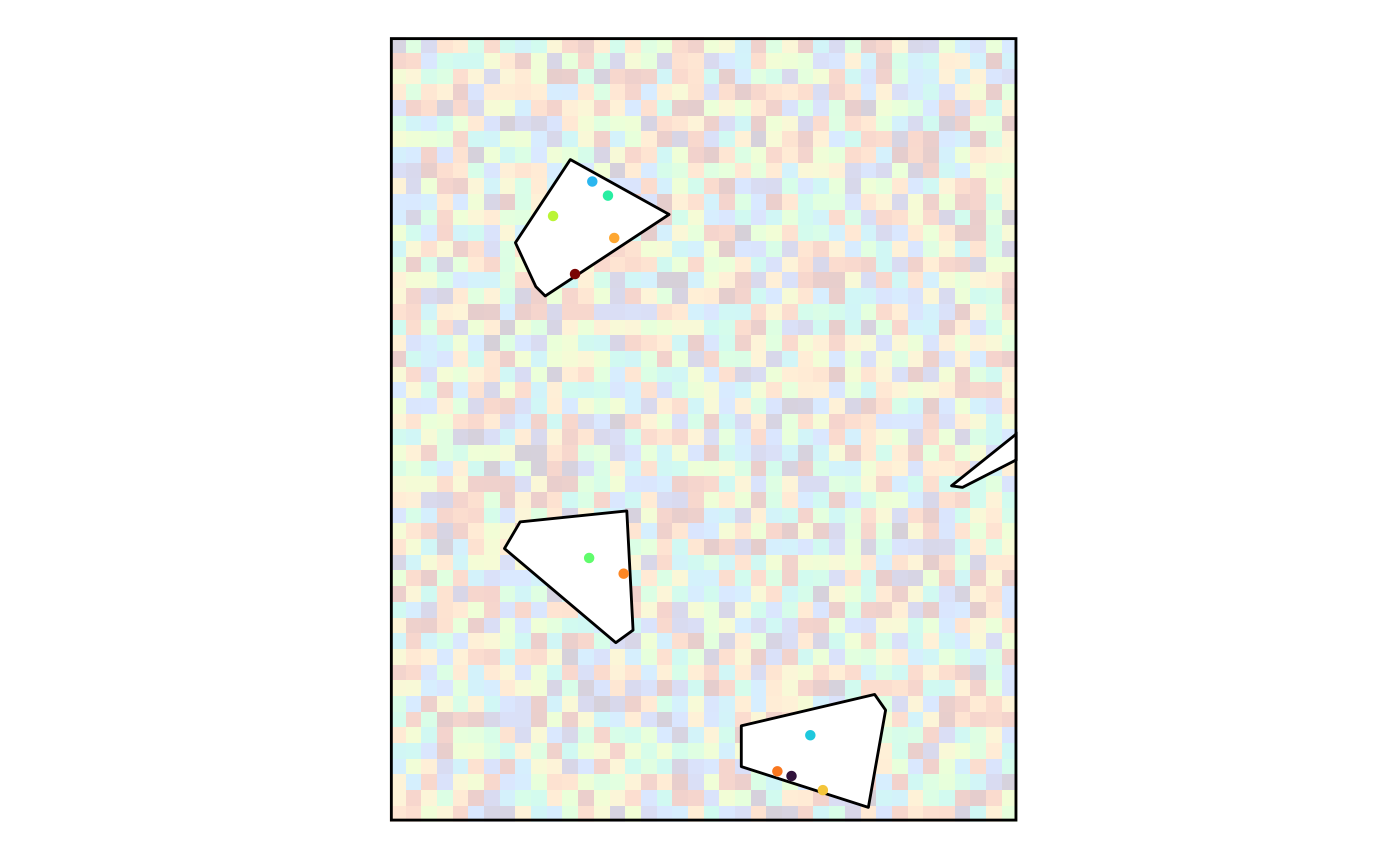 # }
# }
